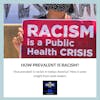How Prevalent is Racism in Today's America?
In a world that strives for equality and justice, the question lingers: How prevalent is racism today? This blog post delves into the multifaceted dimensions of contemporary racism, shedding light on its enduring presence and the ongoing journey towards a more inclusive society.
The prevalence of racism in today’s society varies by region, context, and perspective. While significant strides have been made in combating overt and systemic racism, it still persists in various forms, from microaggressions and biases to hate crimes. Racial disparities in areas like employment, education, and criminal justice underscore the enduring challenges. Measuring its exact prevalence is challenging, but its impact on individuals and communities remains a critical concern, necessitating ongoing efforts to promote equality and combat discrimination and hatred.
Those who aren't blind to the facts, would agree that racism isn't necessarily getting worse, it's just getting filmed and witnessed at a higher clip. It has always existed, and it is still very much alive today. It is a public health crisis that is still causing division in ways that contradict the laws of logic, reason, and any semblance of morality. As an Afro-Latino, I have lived between and seen both sides of the spectrum. (See my article titled: "Afro-latinos Need to Embrace Their Blackness") I want to start the conversation about racism’s prevalence in America today.
How prevalent is racism in today's America? Here are the insights these leaders shared.
- Observations of Decreased Racism and Increased Diversity
- Racism's Persistence and the Need for Change
Observations of Decreased Racism and Increased Diversity
Racism has decreased significantly compared to the '90s and early 2000s. Some might feel it has increased due to events like the COVID-19 pandemic, but in today's society, there is a noticeable increase in interracial relationships and diverse social interactions.
In the past, people tended to stick to their own racial groups, especially in poorer neighborhoods. The wealthier areas were more diverse, but in less affluent areas, differences often led to daily bullying and fights from racial tension.
Now, young kids at school are seen hanging out across different races, and the racial segregation once experienced seems to disappear. This change is evident in places like restaurants, where there's a mix of races enjoying various cuisines. Unlike before, when certain restaurants were mainly attended by specific ethnicities, now a diverse mix of people are seen enjoying Pho, Mexican food, Korean BBQ, and more. People are waking up to our differences and accepting them.
Al Tran, Realtor, Blogger, Author, DS Inspire
Racism's Persistence and the Need for Change
Racism remains a significant and prevalent issue in today's America, despite ongoing efforts to combat it. It manifests in various forms, including systemic racism, implicit bias, racial profiling, and discriminatory policies. These issues disproportionately affect Black, Indigenous, and People of Color (BIPOC) communities in areas such as education, criminal justice, employment, and healthcare.
Recent events and social movements, such as Black Lives Matter, have brought increased awareness to the issue and sparked conversations about racism's persistence. While progress has been made in addressing racial disparities, there is still much work to be done to achieve true equity and justice. It is essential to continue advocating for change, fostering inclusivity, and challenging discriminatory practices to create a more equitable society.
Aviad Faruz, CEO, Know Mastery











